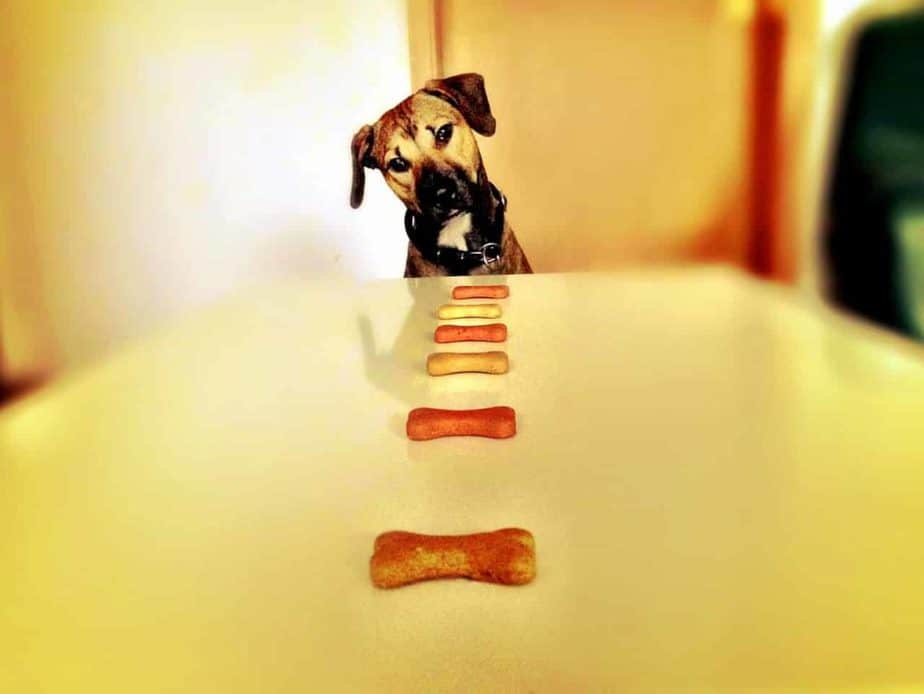Crate training without treats isn’t a recent subject of debate, in fact, training without treats, in general, is a very popular method.
Plenty of pet parents and dog trainers preach this method for multiple reasons, but mainly because most dog owners are confused about the use of training treats.
Sometimes training treats when overused can lead to health issues, or when misused backfire and dogs only respond when they get treats.
To avoid all of these potential issues some dog guardians and trainers prefer using alternative methods.
When it comes to crate training treats are a great tool in the dog owner’s arsenal to do it fast and effectively. However, this does not mean it can’t be done without treats.
Can you (crate) train dogs without treats? this is the question we will be answering with details in this article.
In a hurry?! Use the Kong toy and fill it with some of the dog’s main food and use it as a puzzle to reward the dog (Click here to get yours on Amazon).
Why crate training without treats
As I’ve stated in my introduction, most dog owners choosing crate training without treats are mostly concerned about the use of training treats and how much they should use or when/how to stop so they just make a decision to opt for alternatives.
However, there are plenty of valid reasons why you can choose to crate train your dog without treats.
Let us explore some of these situations and see if there is something you can actually do about it.
I’m using too many treats
Many dog guardians don’t really know what’s the daily calorie intake of their dogs and would rather not risk causing any potential health issues overusing treats.
I consider this responsible behavior, and good dog parenting, I rather people overlooking the use of treats than giving too much to their dogs.
However, if this is the only objection one would have about training treats I would recommend getting advice from the vet or a certified dog trainer for the optimal daily intake of treats and using them for faster training results.
Dog only obeys with treats
Dogs are different and some dogs will only obey their trainer/parent when given treats.
This is common especially for new inexperienced dog owners, but sometimes it could be totally related to the dog’s nature.
When your dog only responds to treats you need to make a change and take treats out of the equation once and for all.
It will take some time but you need to start over using other methods.
Dog too focused on treats during training
This is most commonly a rookie mistake in dog training, meaning you’ve made the treats the center of attention and the ultimate goal of doing the exercise.
This is often due to using the treats too much and bad timing, you did not make a good job associating the treat with great behavior.
More on this point treats are not to be given every single time the dog does what you ask him.
Just like work they don’t give you a bonus for showing up, you are supposed to do that! but when you show up and work hard and accomplish more than expected then you get a bonus if you’re lucky and keep doing it.
Your dog doesn’t like treats
Some dogs just don’t like treats, yeah you’ve heard right this is not very common but it happens.
And most of the time you just got treats that aren’t very appealing to your dog and you could try a new brand.
I personally use Bil-Jac treats, every dog I’ve given them to loved them and I like the fact that the brand is trusted and contributes to a good cause providing service dogs for veterans.
The pros of crate training without treats
There are benefits to crate training without treats and here are the most important ones:
- You don’t have to make a special schedule and follow up on the daily calorie intake of your dog.
- It costs less not to use training treats.
- The dog learns to obey without treats so you don’t have to deal with the phase-out.
- Your dog learns to appreciate verbal praise and physical touch which makes the bond stronger with you.
- The dog is less exposed to overfeeding, obesity, and any potential treat-related issues.
Generally, dog owners who train their dogs without treats, establish better communication with their dogs.
The cons of crate training without treats
There aren’t really a lot of cons to crate training without treats, it is mainly the time and effort inconvenience.
Using the treats makes training fun enjoyable but most importantly faster. let’s take the first step of crate training a puppy which is introducing your dog to the crate. It would be really harder to lure the dog in the crate if there are no treats.
Of course, when something is harder it does not mean it can’t be done, there are always alternatives it’s just that with training treats you can do it faster.
Is crate training without treats your best option
Crate training without treats would not be your best option if you are looking for fast results.
If you live in an apartment and need to crate train your dog really fast to avoid any complaints from the neighbors then treats are inevitable. by the way, if this is the case for you, read this article about crate training in an apartment it will help you.
I personally recommend training with treats, I find it to be a more enjoyable process and more efficient, however, if you are looking for a more fulfilling and better bonding experience I encourage you to crate train your puppy without treats.
If it’s the number of treats and how to phase out that seems to much work for you, it is something you can easily learn. I wrote an article about training treats and how to use them that will help you.
What are some alternatives to crate training treats
There are only two alternatives to crate training without treats:
Crate training with chew toys
When crate training you need a motivational tool it is often the treats, but toys could very much do the same thing or anything really that gets your dog excited.
I often recommend using the KONG chew toy (click here to check the current price on Amazon) it is perhaps the best training toy out there.
Dogs love chew toys, they allow them to relax, Chewing releases endorphins that calm your dog down and produce feelings of contentment.
It is also a great way to keep your dog busy in his crate after meals and when you are not home.
Your dog can have access to his chew toy at all time, unlike other interactive toys.
You can also use food (your dog’s daily meal not treats) and stuff them in the Kong to create a great food puzzle that will keep your dog busy for a while making him less likely to show objection to being in a crate.
Interactive toys
Interactive, on the other hand, can’t be used all the time but only during playtime with you.
And it helps a lot get over treats, dogs naturally love to play with us so if you use the toy as a reward for good behavior it will help you achieve good progress with your training.
These play sessions with interactive toys should be the ultimate reward for your dog and he needs to be on his best behavior to get to play with you.
This way you can turn a simple toy into a powerful motivational tool to enforce good behavior.
Verbal praise and physical contact
Dogs are animals that love to please, they feel contentment when they please us, so why not use that as a motivational tool to make training easier.
Don’t underestimate the influence of verbal praise and a simple belly rub on your dog.
Some dogs are more responsive to their guardian encouragement than treats.
In fact, using rubs and praise is a must in dog training as it is the best way to bond with your four-legged partner.
Do it only when the dog does something you like, this way you can associate it with good behavior and use it for training.
How to crate train your puppy without treats

Crate training without treats doesn’t change the training process, the steps are always the same only a few tweaks here and there and that’s it.
The main idea behind crate training is basic and straightforward: make the crate great.
You simply want to make the crate the best possible place for your dog to be, so by using common sense anything that your dog hates should not be done in the crate and anything that makes him excited should be associated with the crate and that’s basically it.
Step 1 exploring the crate
The best tip I may give you today is this; never introduce your dog to something when it’s time to do it.
When the dog goes in the crate it should not be the first time he sees one, you have to build up to it.
The best way to do it is to start early during the day and take your dog on a leash to just sniff around the crate and explore it.
When comfortable enough you may lure him inside to feel more comfortable about it. And this is where the treats are actually very helpful because encouraging your dog to get in a crate is not easy without treats.
You want to use a toy and just toss it inside to get him inside the crate and once he is you want to praise him hard and rub his belly like he’s won the lottery.
I strongly recommend using the wire crate for crate training especially one with two doors because it makes it way easier to explore the crate.
The wire crate provides a lot of open space and dogs are more willing to get inside it which is very helpful in this crucial step of crate training.
I recommend the Midwest double door wire crate (click here to check the current price on Amazon) other than what we said before I like it because it gives you a lot of options; there is a crate cover that fits if you want to make the crate more intimate at night and there is a playpen that attaches to it if you want to use one for your dog which is not a bad idea especially at the first few months.
Step 2 Making the crate great
Food is one of the best things you can associate with the crate to make it a nice place that’s why crate training without treats is harder. However, you can always feed the dog his meals in the crate.
Also, secure a toy inside the crate to get your dog to like it anything your dog likes must be associated with it.
If your dog has a special bed or a toy he is attached to it use it, what’s important is to make the crate great.
Never punish your dog inside the crate, it is supposed to be a safe place not a time out zone and that’s a big mistake many dog owners make.
Step 3 Testing the crate
Use the feeding time to start gradually testing your dog’s reaction to closing the crate. Of course, you want to be sitting next to the crate talking to your dog when you close it.
If your dog shows any objections don’t force it, go slowly until he pays no attention to it.
Slowly increase the time the crate stays closed after the meals and you want to use a chew toy at this point to keep the dog distracted from the fact that he has to stay inside the crate.
A great tip is to exercise your dog before going into the crate when the dog is low on energy he is more likely to just lay down chew on his Kong and relax.
Step 4 Home alone 1
When your dog is spending more time inside the crate you can start moving around the room.
At first, you had to stay next to the crate but now you can move around just stay insight and test his reaction.
If you see progress and your dog is fine you can leave the room then go by his crate every couple of minutes so he can get used to being in the crate alone.
You want to increase the time you spend away from the crate each time until your dog is fine with you away for about 30 minutes. This is the sign that your dog is ready to be left alone in the crate.
Step 5 Home alone 2
Now that your dog is fine in the crate alone you can leave the house for a short period, 30 minutes to one hour at most.
Another good tip is not to make a scene of leaving the house when you are ready to leave just do it without saying goodbye and interacting with your dog.
He should not associate being in the crate with being left alone so at least five minutes before leaving stop talking to your dog.
The same thing when you return home take a few minutes before talking to your dog and letting him out.
Step 6 First night
Crate training at night is not as hard as most people imagine it is, maybe the first couple of nights but after that, it is really easier than during the day.
All you have to do is make sure your dog had plenty of exercise just before getting in the crate.
You also want to take your dog for his potty break before he sleeps so he doesn’t wake up much during the night. You want to stop watering your puppy at least 2 hours before he goes to sleep.
If you do a good job during the day even day 1 the first night won’t be very hard since the dog is already tired and needs to sleep.
Younger puppies sleep up to 18 hours a day, make sure the active hours are during the day.
Keep the crate close to your bed so you can hear your puppy if he wakes up for a potty break or if he needs comfort.
At night, treats are not needed anyway, so crate training without treats won’t make a difference at night.
How to phase out on treats if you’ve been using them
If you’ve been using the treats and want to phase out there are 3 easy steps to follow:
Removing the lures
At first, your dog needs to see the treat in your hand and he knows that if he does what you say he’ll get a treat.
What you want to do is to remove it from your hand into your pocket and when he does what you ask reward from your pocket.
This helps the dog understand that even if he can’t see the treat he still going to get it if he does what you ask.
Reduce the number of treats
The next step is to reduce the number of treats per action, meaning the dog has to work even more for a treat.
If you’ve been giving him a treat per command now reduce it to 1 per 5 commands.
This will make the dog try to constantly perform better to deserve that treat.
Replacing the treats
Step 3 is to show your dog that there are other ways to reward him other than treats.
Instead of giving treats for good behavior you can take your puppy to the couch and give him a nice rub.
You can use verbal praise then take him out a bit. And on the way ask him for other commands then continue the walk as a reward.
Your dog will eventually be happy if you’re happy and will perform better to please you.
You can’t, of course, phase-out on treats overnight but it takes mostly a week or two.
Should you crate train without treats
If you can crate train without treats then absolutely go for it. It will be much better for your dog and will help you avoid a lot of potential health issues related to treats.
Using too many treats or ones that are too high on calories could lead to obesity you can read this study about the relationship between feeding patterns and obesity in dogs.
Crate training without treats is certainly harder but it is much better for your dog.






